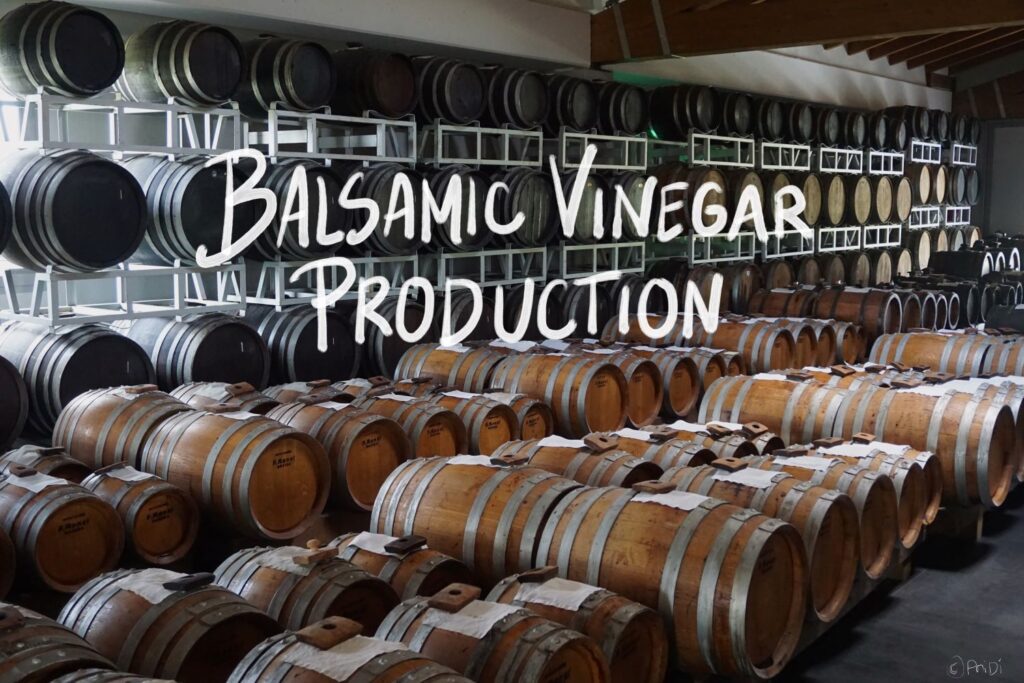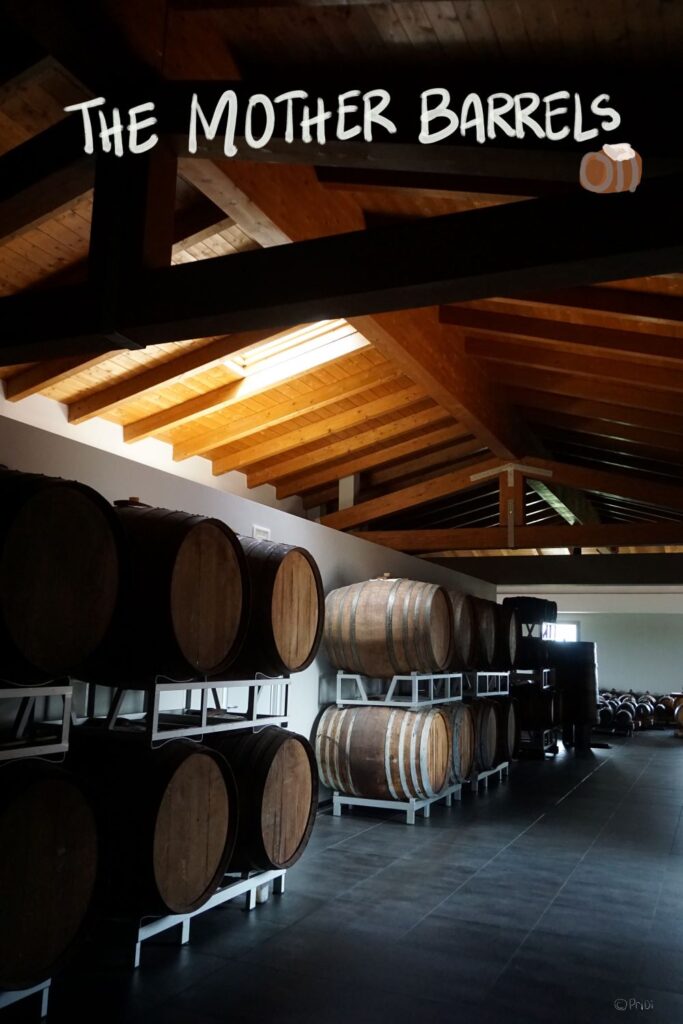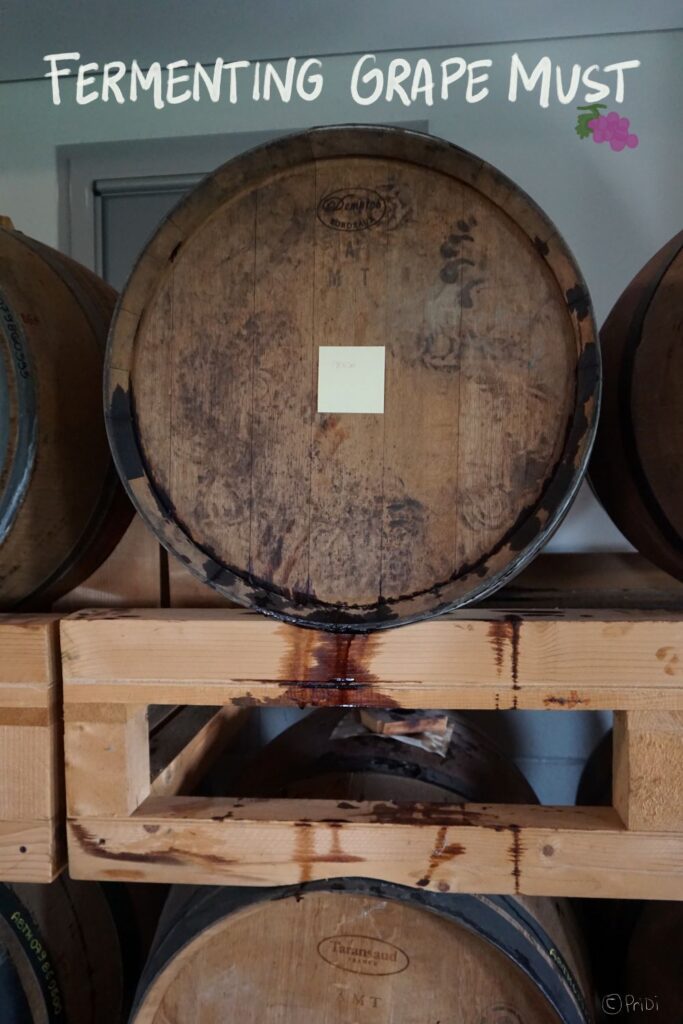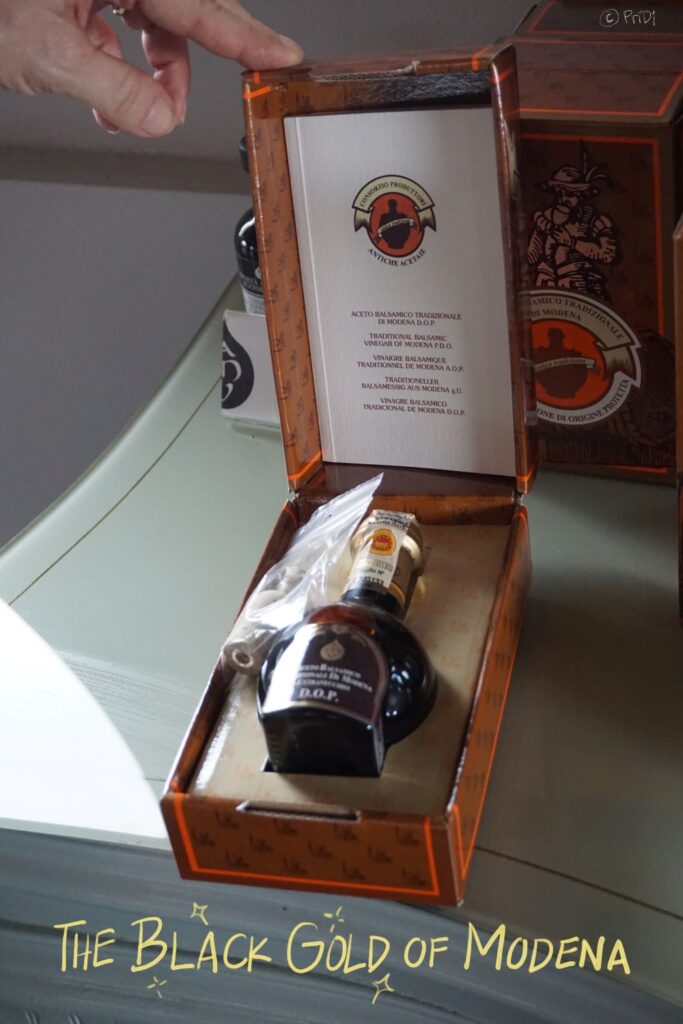Estimated reading time: 10 minutes

During my recent travels to Italy, I had the privilege of visiting an acetaia, an authentic balsamic vinegar making factory. It is so precious that people call it the Black Gold of Modena.
Curious about the production of the legendary balsamic vinegar of Modena? Find out why it’s such an iconic part of Italian cuisine!
Table of contents
- What Is Balsamic Vinegar of Modena? ✨
- Where Is Balsamic Vinegar Made & What Are the Types? 🍇
- Why Is It So Expensive? 💵💶
- Fake vs. Real Balsamic Vinegar
- Can Balsamic Vinegar Expire or Go Bad?
- Vinegar Drama?! 💅🏻
- Now, How is Balsamic Vinegar Made? 🪄
- Celebrating with Vinegar 🥳
- Tasting Time!
- How to eat balsamic vinegar?
What Is Balsamic Vinegar of Modena? ✨

Don’t compare the real thing to commercial balsamic vinegar from the grocery store!
Balsamic vinegar is a condiment produced from grape must grown in the provinces of Modena and Reggio Emilia. It is made out of Lambrusco and Trebbiano grapes, crushed with its juices and pulp. The crushed fresh grapes undergoes a fermentation process until it reaches a thick consistency in wooden barrels.
The production process can take months- even up to 25 years! The purpose is to reach the perfect balance of flavor and texture.
The aging process can be different for the two different types of balsamic vinegar certification: IGP (Indicazione Geografica Protetta) and DOP (Denominazione di Origine Protetta).
Where Is Balsamic Vinegar Made & What Are the Types? 🍇
The only regions certified to produce real balsamic vinegar IGP and DOP are Modena and Reggio Emilia. Balsamic vinegar of Modena, similar to the Parmigiano Reggiano cheese, is a protected product from Italy.
The difference is that there are 3 types of protected balsamic vinegar: Traditional Balsamic Vinegar of Modena (DOP), Traditional Balsamic Vinegar of Reggio Emilia (DOP), and Balsamic Vinegar of Modena (IGP).
Why Is It So Expensive? 💵💶
It actually depends on what kind we are talking about! Balsamic vinegar IGP (Protected Geographical Indication) can be much cheaper than balsamic vinegar DOP (Protected Designation of Origin) due to its production process.
The traditional methods, certified by the Italian DOP council, is much more time and labor intensive. Producing vinegar requires a 12-year minimum aging process, where the vinegar is left fermenting in multiple barrels.
Traditional, DOP-certified balsamic vinegar can cost around $200. Meanwhile, the modernized IGP vinegar only needs to go through acidification for 60 days (up to 3 years) and can be mixed with up to 50% wine vinegar. IGP-certified balsamic vinegar ranges from $5 to $50.

Fake vs. Real Balsamic Vinegar
If you bought a bottle from your grocery store, far away from Italy, it is probably fake balsamic vinegar! Since the traditional process is so long and the requirements so strict, it limits the annual production of true traditional balsamic vinegar.
They can only produce up to 8,000 litres each year!
Look at the ingredients label: if there is anything besides mosto cotto (cooked grape must), you got the fake one. Traditional balsamico DOP will never have any other additions.
Can Balsamic Vinegar Expire or Go Bad?
Since balsamic vinegar has a lower pH and is acidic in nature, it has a prolonged shelf life. Acidity inhibits bacteria growth, which is why pickles (when properly made) lasts way longer than its fresh counterpart! As for traditional balsamic vinegar, the condimento bottle I bought in Italy has a 9-year expiration date on its packaging.
Storage temperature and condition will, of course, affect the quality and taste of your opened product. It is best to store it in a cool, dry place away from direct sunlight. Avoid contamination of any other kind of food, which can introduce mold into the bottle. With the right storage condition, traditional balsamic vinegar can practically last forever!
If you have products such as balsamic vinegar cream or other blends, it will last a few weeks after opening (always reference the best by date). Watch out for any molds or change in consistency or smell before consuming.
Vinegar Drama?! 💅🏻
While researching for this article, I came across a document full of ✨drama✨ between balsamic-producing countries. European Union countries Germany, Greece, and France objected to Italy’s claim to the name “Aceto Balsamico di Modena”!
Both Germany and Greece claimed that this name is too generic to be claimed by Italy and will hurt sales of balsamic-branded items from their respective countries. On the other hand, France stated that it does not have enough reputation to stand on its own, unlike the previously-approved trade name “Aceto balsamico tradizionale di Modena”.
After an investigation by The Commission, they found that there is enough factors to differentiate the name and production of Aceto Balsamico di Modena. The protest regarding the name is also referencing to individual words and not the entirety of the phrase, therefore it can be protected.
So watch out for products containing just “aceto”, “balsamico”, or “aceto balsamico”- these are not the real deal from Italy!
Now, How is Balsamic Vinegar Made? 🪄
My tour started in Parma, Italy in the morning. We visited a parmesan cheese (Parmiggiano Reggiano) factory, continued with a prosciuttoficio (prosciutto factory) after, and a stop at the acetaia (balsamic vinegar factory) after.
The acetaia I visited was Società Agricola Acetomodena, located in the city of Modena. They have different parts of the facility dedicated to the production of DOP and IGP balsamic vinegar.
While the IGP vinegar is produced in the modern factory below, the traditional vinegar-making facility is situated upstairs. It was filled with a series of wooden barrels, called batteries, placed side-by-side from big to small.
DOP and IGP: Sisters from Another Mister 👯♀️

The two types of certification, DOP and IGP, is differentiated by the production process. DOP-certified balsamic vinegar product is done traditionally, aging for a minimum of 12 years. Producers only use grapes harvested and processed in Modena, and only certain varieties at that. Meanwhile, grapes destined to be IGP-certified vinegar can come from different regions, accommodating a larger-scale manufacturing process.
After harvesting, these grapes would be crushed to produce grape must– a mixture of grape juice, pulp, seeds, skins, and stems. Grape must would then be cooked at a temperature range of 70 to 95 degree Celcius. The exact duration may vary, depending on the producer’s discretion. 🍇
Patience is Virtue

The cooked grape must would be cooled and placed in wooden “mother barrels”. Grape must will ferment into alcohol, which in turn will transform into vinegar.
Yeast, enzymes, and bacteria are all part of this beautiful symphony, with balsamic vinegar as its cavallo di battaglia 🐎. The placement of barrels of decreasing sizes is not a coincidence nor an aesthetic choice!
In the traditional method, the vinegar is moved from the biggest barrels to increasingly smaller ones to evaporate and mature. After maturing for a minimum of 12 years, this masterpiece would be ready.

The oldest DOP balsamic vinegar can be matured for as long as 25 years, and will have the designation of “Extravecchio” (extra old). After the producer extracts the vinegar from its final maturation process, they will then take their batch to the bottling center.
The vinegar will be measured for its density (> 1.24) and acidity (> 4.5), and then tasted by 5 certified tasters. Only after securing their approval it can be sold with the official DOP certification.
It would then be packaged with in a special bottle designed by Giorgietto Guigiaro. He is a car designer who worked for Ferrari and Maserati!

With the IGP certification, the vinegar will go through a different process after cooking and cooling. The cooled grape must ages in a wooden barrel for 60 days, does not go through fermentation, and then mixed with wine vinegar.
IGP also allows addition of caramel coloring and thickening agents to improve flavor and texture. These rules allow IGP balsamic vinegar to be produced in a larger scale and with lower production costs, resulting in a more budget-friendly product.
Celebrating with Vinegar 🥳

Interestingly, our host explained that they start new balsamic vinegar barrels for special occasions as well. Weddings, birthdays, they were all commemorated with a special series of vinegar.
A family business lasting for 3 generations, their oldest barrel has been in use for 150 years! They use high-quality oak, cherry, or juniper to impart different “bouquets” of aroma to their finished product.
The DOP Consortium is basically a regulating body and marketing agency all rolled into one. They check on the producers’ facility, ensure that all rules are followed during production, and promotes their product to the rest of the world!
Tasting Time!

After a thorough explanation of the process, our host gave us some samples for tasting. I was so excited to taste the top-of-the line 25 year old DOP balsamic vinegar!
I tasted all kinds of vinegar, from the very acidic Nero IGP to older and more mature DOP vinegars. They all definitely have their own unique flavor.
The acidic tang of the vinegar gets more and more mellow with age, and the evaporation process created a more viscous texture. The highest quality 25 year-old vinegar had the sweetest and had the thickest texture. It reminded me of kecap manis– a sweetened, fermented Indonesian soy condiment.
How to eat balsamic vinegar?
With the more mature vinegars, our host informed us that they should not be cooked or reduced. They should be enjoyed in their pure form, as a condiment to your food. The younger and more acidic IGP vinegars, on the other hand, can be reduced to bring out its sweetness.
Reduced balsamic vinegar can be made into balsamic glaze, which has a thick syrup consistency. It has a sweet-and-mellow, rich flavor. Balsamic glaze would be a wonderful addition to pizzas, salad dressing, even vanilla ice cream! It can accentuate the ingredients’ freshness.
I hope you found this article useful! Please share and leave a comment if you want to know more about this experience.
P.S. = If you are looking for things to do in Italy, read about my tour into the Prosciutto di Parma factory and Parmiggiano Reggiano cheese factory! 🧀

Pin It!




